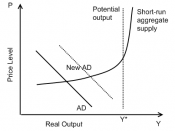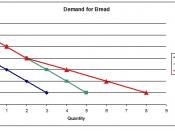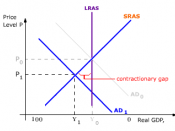Summary
This article talks about the competition that is going to be taking place involving technological satellites. Currently the United States holds the bar for commercial telecommunications satellites and Europe is gaining ground for developing and launching a new generation of high-powered spacecrafts. The satellites will be aimed at improving internet access and also those of military applications.
Definition of the Principle
The new satellite competition illustrates the determinant of expectations of Aggregate demand. Aggregate demand is the demand for a country's Gross Domestic Product (GDP). GDP is comprised of consumption, investment, government spending, and net exports. Aggregate demand as a graphical representation gives a picture of an entire economy, considering both the total output and the price level. To analyze aggregate demand, we plot a line on a graph. This graph measures real output (the horizontal axis) and price level (the vertical axis). Like other demand curves, aggregate demand is downward sloping because price level has an inverse relationship to real output.
This means that as the price level raises total output will decrease. This inverse relationship occurs because as the price level increases all goods and services become less affordable and total output falls. Conversely, as the price level decreases, goods and services seem to be more affordable, so total output rises.
Ancillary Definition
The aggregate demand curve interacts with an aggregate supply curve. The intersection of these curves is the equilibrium point, where price level is set to optimize total output. There are tow portions of the aggregate supply curve, the short run and the long run. We will discuss only the long run aggregate supply curve here, as short run aggregate supply will be defined in a later article. In the long run, when an economy is at its full capacity, aggregate supply is...


